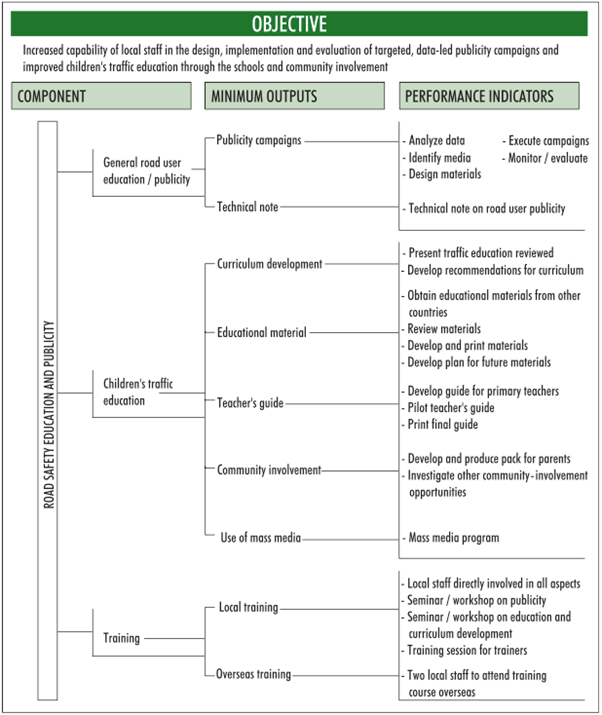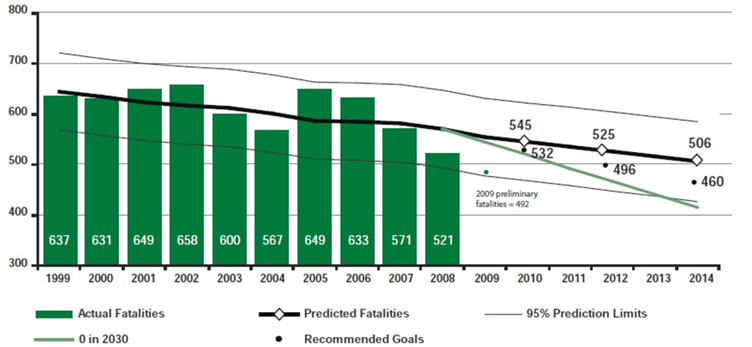12.3 Evaluating Road Safety Targets, Including Intermediate Targets
Chapter 6. Road Safety Targets, Investment Strategies Plans and Projects described the process required to set quantifiable road safety targets as part of policy development and plans. As discussed in that chapter, there is a requirement to constantly monitor and analyse progress against these targets.
Specific programs have been developed in various countries to do this, with each part of the action plan being provided with a clear objective, required outputs, and a series of performance indicators for each output. Road safety objectives can thus be assessed in terms of progress being made towards a minimum desired level of activity in that sector. This idealized framework then provides a ‘scoring frame of reference’ against which actual performance can be evaluated.
For example, an action to plan to deliver effective road safety education should include all activities related to road safety education and publicity. Figure 12.2 shows what may be taken to be the component parts of this activity: the minimum outputs and the performance indicators. Progress relating to education and publicity can be assessed on a regular basis by referring to this figure.

As well as monitoring long- term targets, there is also a need to ensure that relevant agencies and government departments are implementing the improvements outlined in the plan through monitoring of intermediate targets. As an example, the State of Washington in the United States, previously used the Holt Method (an extended simple exponential smoothing to allow the forecasting of data with a trend) to forecast data trends to set near term targets and to set intermediate targets for the strategic highway safety plan. The figure below shows a visual representation. The standard deviation is shown to report a range of what can be expected in the near-term. Also see: Chapter 5. Effective Management and Use of Safety Data.

Such monitoring can also help establish whether these activities are having the desired effect on safety outcomes. In many cases, this monitoring will identify adjustments that can be made to help improve safety outcomes. Data requirements for these activities have been outlined in Chapter 5. Effective Management and Use of Safety Data.
The following section provides guidance on how to analyse and evaluate road safety infrastructure interventions. Some of these approaches can be used to help evaluate performance against targets. However, evaluating the success of interventions in meeting targets can be a more complex task because there are often many changes taking place simultaneously. Solutions to this issue include the evaluation of ‘packages’ of treatments (i.e. determine the effect of the combined activities that are related), or the application of statistical modelling to try to determine the impact of individual measures. Whichever approach is taken, the creation of a strong data collection and analysis process is required to ensure that adequate data is collected. This will include the need for data on final outcomes (crash data) and intermediate measures (safety performance indicators, e.g. various behavioural measures, attitude survey information, and infrastructure measures). For further information on data requirements see Chapter 5. Effective Management and Use of Safety Data.
For further information on the evaluation of non infrastructure interventions, there are a number of important reference documents. These include the UK Evaluation Hub, a website and toolkit on evaluation of education, training and publicity programmes, as well as global good practice documents on helmets (WHO, 2023) and drink driving (GRSP, 2022), speed (GRSP, 2023 and Turner et al., 2024), seatbelts and child restraints (FIA, 2022), two and three-wheeler safety (WHO, 2022), road safety legislation (WHO, 2013).
The Czech Republic case study shows an example of setting and monitoring targets for the countries efforts to reduce number of people killed and injured on its roadways.
CASE STUDY - Czech Republic: National road safety strategy
With 130 persons killed in road traffic per 1 million inhabitants in 2001, the Czech Republic ranked 15th out of the 27 EU countries. Given this unacceptable situation and following principles of Vision Zero and Safe System, as well as European safety policies, National Road Safety Strategy was developed by CDV – Transport Research Centre, which is the only scientific research institute under the Ministry of Transport. The strategic objective of the Strategy 2011 – 2020 is to reduce by 2020 the number of persons killed in road traffic to the average level of European countries and in parallel to reduce by 40% the number of seriously injured. In annual terms, this objective translates to yearly reductions of fatalities by 5.5%. As of 2015 the fatality reduction has not been achieved, but serious injuries are on track. Read more






